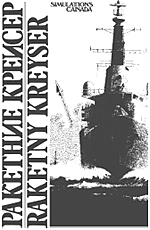 Raketny Kreyser is a game simulation of tactical naval warfare as it might occur in the late 1970’s thru the 1990’s. The naval and/or naval air forces of the U.S., the U.S.S.R., the U.K., the P.R.C., Canada, Turkey, Greece, Norway, Denmark, Sweden, W.Germany, E.Germany, Poland, Finland, Iraq, Iran, N.Korea, S.Korea, Japan, Taiwan, Italy, India, and France are represented by their major combatants and aircraft.
Raketny Kreyser is a game simulation of tactical naval warfare as it might occur in the late 1970’s thru the 1990’s. The naval and/or naval air forces of the U.S., the U.S.S.R., the U.K., the P.R.C., Canada, Turkey, Greece, Norway, Denmark, Sweden, W.Germany, E.Germany, Poland, Finland, Iraq, Iran, N.Korea, S.Korea, Japan, Taiwan, Italy, India, and France are represented by their major combatants and aircraft.
Players 2
Playing Time Varies with scenario
Scale Tactical Turn 12 minutes
Map 1 nautical mile per hex
Units counters represent individual ships and groups of 3 aircraft
Components
1 plastic ziploc container
1 12-page half-size rulebook
1 standard 22"x28" featureless blue map
255 backprinted die-cut counters
SimCan says:
“A broad spectrum survey of the naval and naval air units that would be engaged in any major world conflict from now until the turn of the century. 3 groups of scenarios (Gulfs and Straits, Coastal Seas, Open Ocean) depict likely places of conflict and participants. Silhouette type counters cover the major combatants of over a dozen nations. Backprinting has been used to conceal a unit’s identity and attack values. Surface effect ships and semisubmerged platforms depict future naval trends. Ranged attacks, air detection zones, NTDS, and optional rules covering weather in all the world’s oceans and systems reliability allow players to realistically simulate modern naval combat.”
The Reviewers say:
“Raketny Kreyser is ... both playable and realistic. Once you become accustomed to rolling for systems reliability, you’ll find the game moves quickly. Don’t let my elaborating on a few minor technical flaws deter you from this excellent game.” --John Vanore in F&M 10.
"RK is a worthy companion to Steve’s other contemporary naval game, SSN (GDW). The game system is easy to learn and yet involves some innovative features which add interest without penalizing playability.” --Cliff Sayre Jr. in F&M 10.
Comments
The naval order of battle for the larger navies is fairly complete for 1977 but the game does not include missile boats or any other ship smaller than a frigate, which is an interesting omission since several scenarios take place in choke points where such ships could have a decisive impact. The design assumes that operational level nuclear strikes have been exchanged, however the game does not include any rules for nuclear combat at sea. This includes ship and plane stacking, which is theoretically unlimited. Modern ships never operate that closely together, but spread out over miles of ocean to decrease their vulnerability to nuclear weapons and to provide defense in depth.
The small map area prevents the possibility of one side outranging the other in many situations where that would be an important feature. The scenarios with US carriers are implausible since it is very unlikely that Soviet warships would be able to get so close without being engaged by the carriers’ tactical aircraft. The ranges of various weapons are too great and the lack of ammunition limits for ships or planes is unrealistic. And finally, because of the sequence of play, guided missile ships can not play their role of providing anti-air/ anti-missile protection to the other ships in their battle groups (except in the limited circumstance that an enemy plane is making a bombing attack, and then only if the plane flies next to the ship). Although a simple and quick playing game, it fails to capture the flavor of modern naval combat.
Gary Kato indicated that after releasing this game, Steve Newberg decided he didn’t want to design games which the military could use to train people, so he turned his efforts to historical settings.
Collectors Notes
This is the least common of the SimCan games. Boone lists low, high and average prices of 2/4/3.00 at auction and 20/20/20.00 for sale.
Errata
- The gun range on the Sherman counter should be 26.
- All Buccaneer counters should have a “U” movement allowance.
- The silhouettes on the A-6 Intruder and A-7 Corsair counters are reversed; the data on each counter is, however, correct.
Steve Newberg says:
This one was supposed to be the simple game of the three for that year. It was, and was perhaps too simple. With only air and surface elements represented, it was a clean and fast game of modern naval combat, but not the full story. It was fast and violent though, and sold out quickly. We redid the concept (much more to my satisfaction) some years later with Battle Stations.
Back to Simulacrum Vol. 3 No. 2 Table of Contents
Back to Simulacrum List of Issues
Back to MagWeb Master Magazine List
© Copyright 2001 by Steambubble Graphics
This article appears in MagWeb (Magazine Web) on the Internet World Wide Web. Other military history articles and gaming articles are available at http://www.magweb.com